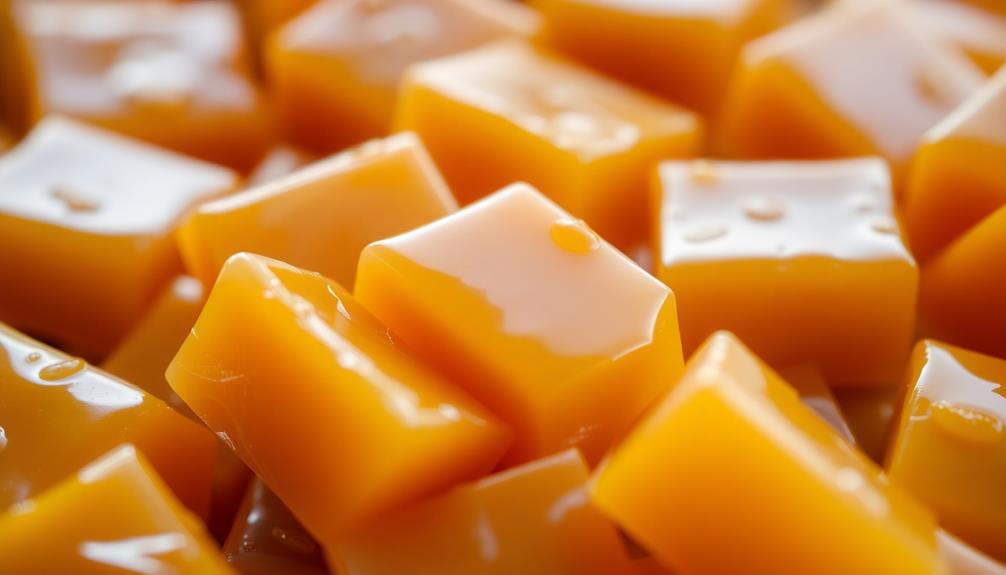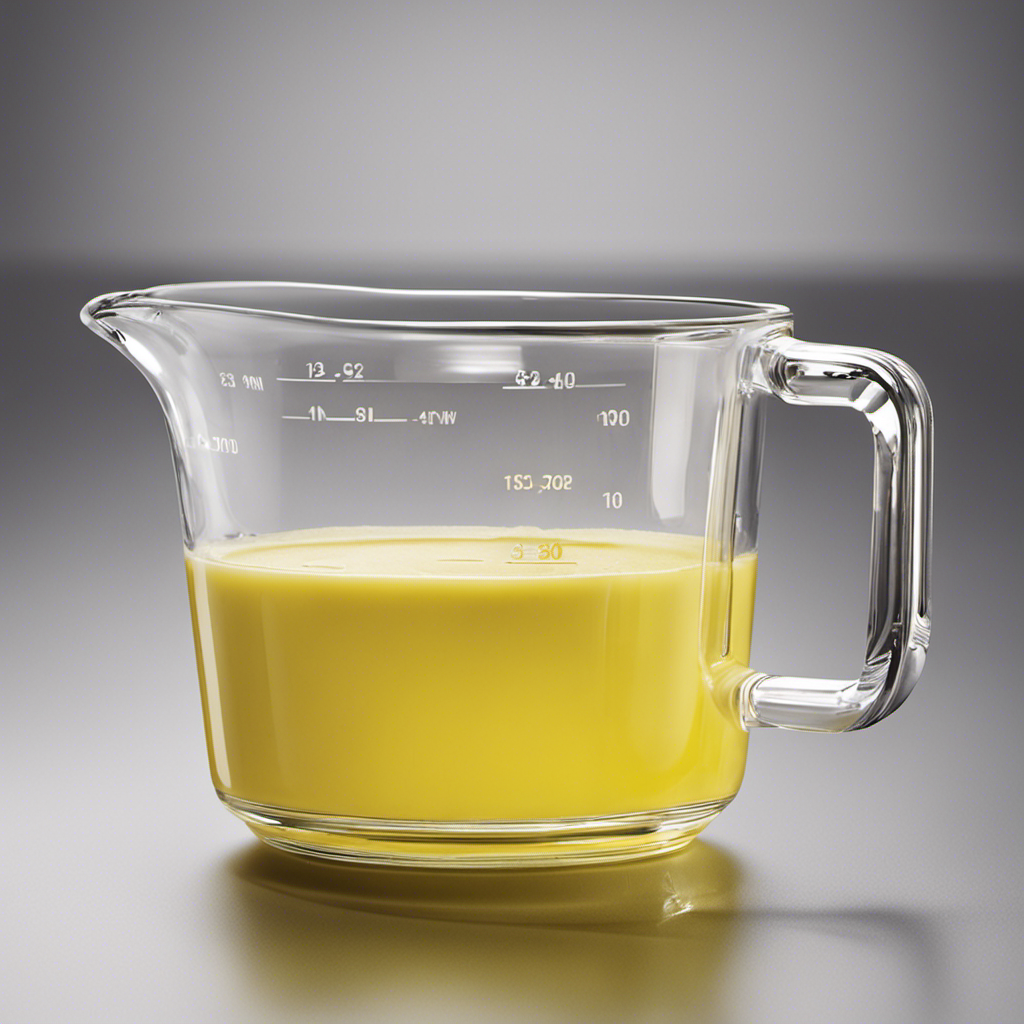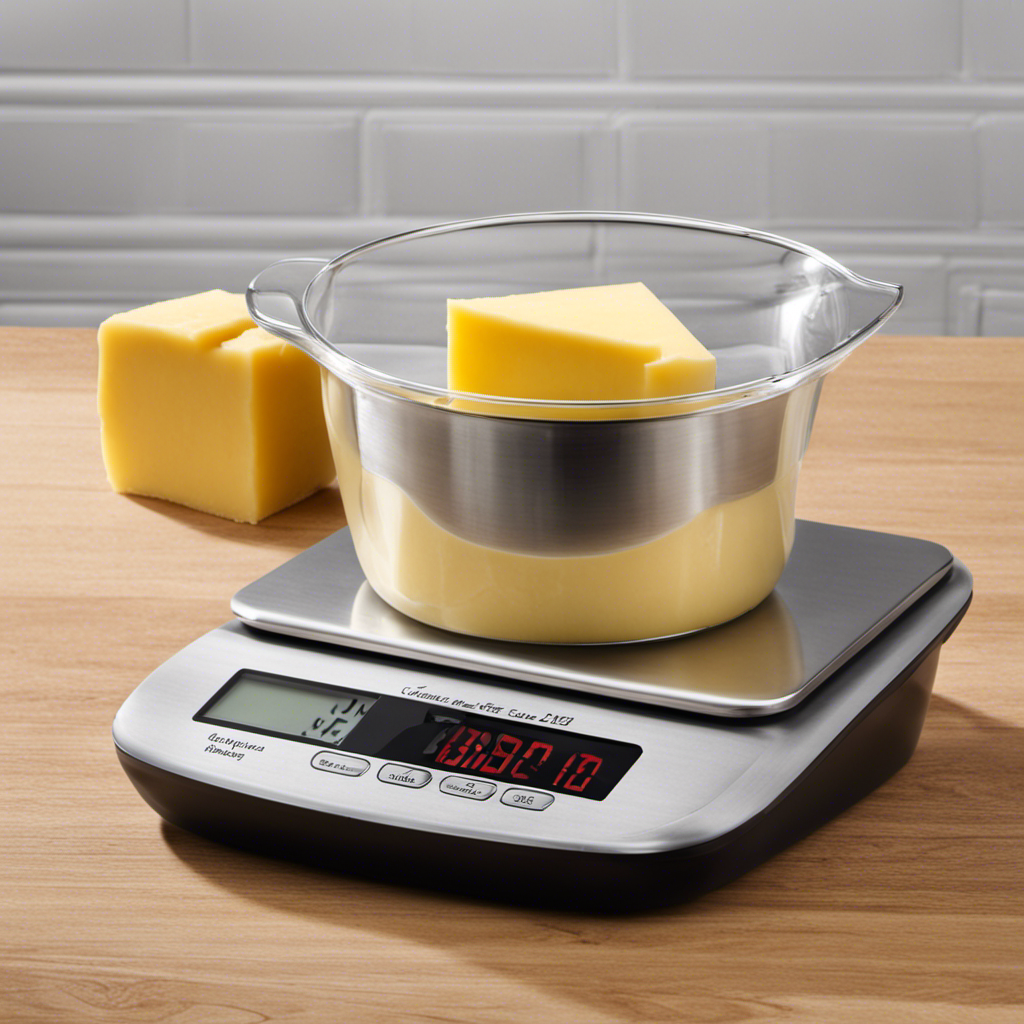Ever curious about the shelf life of butter in the freezer? Great news awaits you!
In this article, I’m going to dive into the science behind freezing butter and share some helpful tips to maximize its shelf life.
We’ll explore the factors that affect butter’s freezer storage, proper packaging techniques, and how to safely thaw frozen butter.
So, get ready to unlock the secrets to preserving butter’s rich flavor and texture in the freezer!
Key Takeaways
- Freezing butter slows down bacteria and microorganism growth, preventing spoilage.
- Proper packaging, such as airtight containers or freezer bags, prevents freezer burn and preserves freshness.
- Thawing frozen butter can be done at room temperature or using alternative methods like the microwave or water bath.
- The recommended storage time for frozen butter is 6 to 9 months, and signs of spoilage include freezer burn and mold growth.
The Science Behind Freezing Butter
If you’re wondering about the science behind freezing butter, it’s all about preserving its freshness and extending its shelf life.
Butter preservation is important because it is a dairy product that can spoil quickly if not stored properly.
Freezing techniques come into play when we want to keep butter for an extended period of time without it going bad.
When butter is frozen, the low temperature slows down the growth of bacteria and other microorganisms that cause spoilage.
Freezing also slows down the oxidation process, which helps to maintain the flavor and quality of the butter.
Factors That Affect Butter’s Freezer Shelf Life
Factors like temperature, packaging, and air exposure can affect how long butter stays fresh in the freezer. To ensure your butter remains in optimal condition during prolonged freezing, consider the following:
-
Temperature: Keep the freezer at a consistent temperature of 0°F (-18°C) or lower to prevent the butter from thawing and refreezing, which can impact its quality.
-
Packaging: Properly wrap the butter in airtight, freezer-safe packaging to prevent freezer burn and the absorption of odors from other foods in the freezer.
-
Air Exposure: Minimize air exposure by removing as much air as possible from the packaging before sealing it. This will help preserve the butter’s freshness and prevent oxidation.
Properly understanding and implementing these factors can significantly extend the freezer shelf life of butter.
However, if you’re looking for butter alternatives that have a longer shelf life, you may consider exploring options like ghee or margarine. These alternatives have different characteristics and can be stored for longer periods without compromising their quality.
Proper Packaging for Freezing Butter
Properly wrapping butter in airtight, freezer-safe packaging helps prevent freezer burn and preserves its freshness. When it comes to freezing butter, it is important to use the right packaging to maintain its quality and flavor.
Here are some guidelines for properly wrapping butter to prevent freezer burn:
- Use airtight containers or freezer bags specifically designed for freezing food to keep out moisture and air.
- Wrap individual sticks of butter tightly in plastic wrap or aluminum foil before placing them in the freezer bag or container.
- Label the packaging with the date of freezing to keep track of its freshness.
How to Thaw Frozen Butter Safely
When thawing frozen butter, it’s best to let it sit at room temperature for a few hours until soft and spreadable. This allows the butter to gradually thaw without compromising its texture or taste.
However, if you need to thaw butter quickly, there are a few alternative techniques you can try:
-
Microwave Method: Place the frozen butter in a microwave-safe bowl and heat it in short intervals, checking and stirring regularly to prevent melting.
-
Water Bath Method: Fill a large bowl with warm water and place the sealed butter container in it. Stir the water occasionally to help distribute the heat evenly.
-
Grating Method: If you only need a small amount of softened butter, consider grating the frozen butter using a cheese grater. This will help it soften quickly.
Remember, these thawing techniques are meant to be used as alternatives. For the best results, it’s still recommended to thaw butter at room temperature.
If you’re looking for alternative butter substitutes, consider options like margarine, coconut oil, or avocado. These can be used in a variety of recipes and offer a different flavor profile.
Recommended Storage Time for Frozen Butter
For the best quality, make sure to use your frozen butter within the recommended storage time. When it comes to freezing butter, it’s important to know how long it can be kept in the freezer before it starts to lose its flavor and texture.
The recommended storage time for frozen butter is around 6 to 9 months. However, it’s always best to check the packaging or consult the manufacturer’s instructions for specific guidelines.
To ensure that your frozen butter stays fresh and tasty, it’s important to follow recommended storage methods. This includes wrapping the butter tightly in plastic wrap or placing it in an airtight container before freezing.
As for the best butter brands for freezing, some popular options include Kerrygold, Land O’Lakes, and Tillamook. These brands are known for their high-quality butter that freezes well and maintains its flavor and texture even after being frozen.
Signs of Butter Spoilage in the Freezer
When it comes to storing butter in the freezer, it’s important to be aware of signs of spoilage.
Two common issues that can occur are freezer burn and mold growth.
Freezer burn can cause butter to develop a dry, discolored appearance, while mold growth can result in fuzzy patches or a distinctive odor.
Understanding these signs can help ensure that your butter stays fresh and safe to use.
Freezer Burn on Butter
You shouldn’t leave butter in the freezer for too long, as it can develop freezer burn. Freezer burn occurs when moisture in the butter evaporates, causing the surface to become dry and discolored.
Here are three tips to prevent freezer burn and extend the shelf life of your butter:
-
Wrap it tightly: To protect your butter from exposure to air and moisture, wrap it tightly in plastic wrap or aluminum foil. Make sure there are no air pockets.
-
Use airtight containers: Another option is to store your butter in airtight containers or freezer bags. This will help maintain its quality and prevent freezer burn.
-
Label and rotate: If you have multiple packages of butter in the freezer, label them with the date of freezing. This will help you keep track of the oldest butter and use it first, ensuring that none of it goes to waste.
Mold Growth on Butter?
To prevent mold growth on butter, it’s important to store it in a cool and dry place. Mold thrives in warm and moist environments, so keeping your butter away from these conditions is crucial. There are also other butter preservation techniques you can use to extend its shelf life. One method is to wrap the butter tightly in wax or parchment paper to protect it from air and moisture. Another technique is to store the butter in an airtight container in the refrigerator. This helps to maintain its freshness and prevent any potential mold growth. Additionally, you can also freeze butter to further prolong its shelf life. Just make sure to wrap it properly in freezer-safe packaging to avoid freezer burn. By following these butter preservation techniques, you can effectively prevent mold growth and enjoy your butter for a longer period.
| Butter Preservation Techniques | ||
|---|---|---|
| Store in a cool and dry place | Wrap tightly in wax or parchment paper | Store in an airtight container in the refrigerator |
Tips for Maximizing the Flavor of Frozen Butter
Freezing butter helps preserve its flavor and extends its shelf life. When it comes to maximizing the freshness of frozen butter, there are a few key tips to keep in mind:
-
Wrap it tightly: Before placing butter in the freezer, make sure to wrap it tightly in plastic wrap or place it in an airtight container. This will prevent any air from getting in and causing freezer burn.
-
Store it properly: Keep frozen butter away from strong-smelling foods to prevent any odors from affecting its flavor. It’s also a good idea to label and date the butter to ensure you use it before it becomes too old.
-
Use it within 6 months: While frozen butter can last for up to a year, it’s best to use it within 6 months for optimal flavor. After this time, it may start to lose some of its freshness.
Creative Uses for Frozen Butter
I love using frozen butter in my baking because it adds a rich and flavorful element to my creations.
Not only does it enhance the taste, but it also makes the dough flakier and more tender.
Additionally, frozen butter is incredibly convenient for spreading on toast or bread, as it melts slowly and evenly, giving a delicious buttery flavor in every bite.
Lastly, frozen butter can be used as a base for making delicious butter-based sauces and dips, adding a creamy and indulgent touch to any dish.
Flavorful Baking Ingredient
You’ll be surprised by how long you can keep butter in the freezer without sacrificing its flavor as a baking ingredient. Freezing butter is a great way to ensure its freshness and availability for all your baking needs. Here are three benefits of using frozen butter in pie crusts:
-
Flaky Texture: When you use frozen butter in your pie crusts, it creates air pockets as it melts during baking. This results in a flaky and tender crust that everyone will love.
-
Enhanced Flavor: The low temperature of frozen butter helps to retain its natural flavor. This means that your pie crusts will have a rich and delicious buttery taste that will elevate your baked goods to the next level.
-
Easy to Work With: Frozen butter is easier to incorporate into your pie crust dough. It can be grated or cut into small cubes, making it simpler to mix and distribute evenly. Plus, the cold butter helps to keep the dough from becoming too soft or sticky, making it easier to roll out and shape.
Convenient for Spreading
When it’s frozen, it’s easy to spread butter straight from the freezer onto warm toast or freshly baked bread. This is one of the reasons why keeping butter in the freezer is so convenient for spreading.
The creamy texture of the butter remains intact even when it’s frozen, allowing for a smooth and effortless spread. Whether you’re in a hurry or just prefer a cold, refreshing bite, frozen butter is the way to go.
It eliminates the need to wait for the butter to soften at room temperature, saving you time and effort. Plus, the butter stays fresh for a longer period in the freezer, making it a practical option for those who don’t use butter frequently.
Butter-Based Sauces and Dips
When it comes to butter, there’s no denying its versatility in the kitchen. From spreading on toast to adding richness to baked goods, butter is a staple ingredient. But did you know that butter can also be used to make delicious, butter-based desserts? Whether it’s a classic pound cake or a creamy buttercream frosting, butter adds a decadent flavor and texture to these treats.
But what if you have extra butter and don’t want it to go to waste? Freezing butter is a great way to extend its shelf life and have it on hand for future use. Whether you have unsalted or salted butter, it can be safely frozen for up to 6 months. Just make sure to wrap it tightly in plastic wrap or place it in an airtight container before freezing.
Frequently Asked Questions
Can I Freeze Butter in Its Original Packaging?
Yes, I can freeze butter in its original packaging. Freezing butter doesn’t affect its quality as long as it’s properly sealed. It may slightly alter the texture, but the flavor remains intact.
How Long Can I Keep Frozen Butter in the Freezer?
Butter can be stored in the freezer for up to six months. It’s important to wrap it tightly to prevent freezer burn. If you prefer alternatives, consider using a butter bell or keeping it in the fridge.
Can I Freeze Flavored or Herb-Infused Butter?
Yes, you can definitely freeze flavored or herb-infused butter! It’s a great way to preserve those delicious creations. Just make sure to wrap it well and label it for easy identification. Enjoy your flavorful butter anytime!
Can I Use Frozen Butter Straight From the Freezer in Baking Recipes?
Using frozen butter for baking is a game-changer. It’s convenient and adds a flaky texture to pastries. Plus, you don’t have to wait for it to soften! Just grate it straight from the freezer.
Can I Refreeze Butter That Has Been Thawed?
Yes, you can refreeze butter that has been thawed, but it’s best to use it within a few days. To maintain quality, wrap the butter tightly in freezer-safe packaging and label it with the date.
Conclusion
In conclusion, freezing butter is a fantastic way to extend its shelf life and always have some on hand. The science behind freezing butter is fascinating, and understanding the factors that affect its freezer shelf life is essential.
Proper packaging and safe thawing methods are crucial to maintaining the butter’s quality. While the recommended storage time for frozen butter varies, it’s important to keep an eye out for signs of spoilage.
And let’s not forget the amazing flavor possibilities and creative uses for frozen butter – it’s like a culinary adventure waiting to happen! So go ahead, freeze that butter and embark on a journey of deliciousness like never before!










